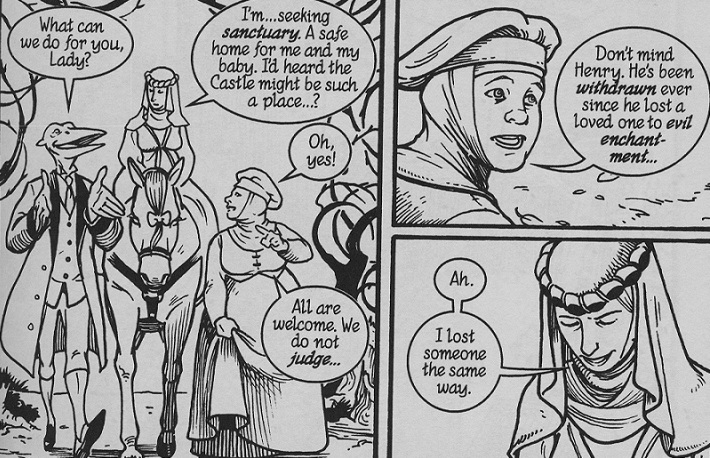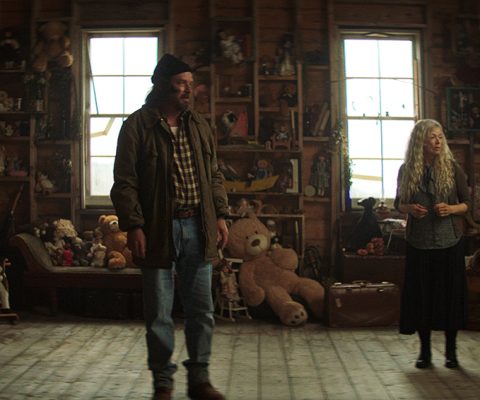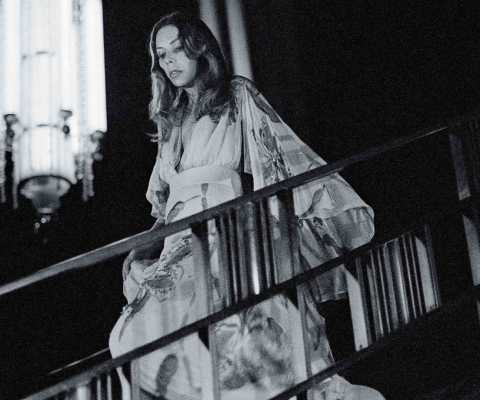Most explicitly feminist literary works understandably depict the struggles associated with forced, and often times dehumanizing, societal constraints. This approach pulls double duty as both a way of generating conflict (which stories kinda/sorta need most of the time usually) and serving as an educational tool and outlet for women’s anxieties over marginalization. Less common, though no less important, reads analyze the philosophy from the angle of speculating what communities truly unencumbered by surface and structural gender essentialism might look like.
At its core, feminism is ostensibly about egalitarianism, though its historical exclusion of women of colour, the LGBTQIA community (particularly trans women), and women of faith doesn’t exactly live up to that ideal. Linda Medley’s Eisner-winning Castle Waiting envisions environments where these divisions have either been largely eradicated or never existed in the first place.
It isn’t that she crafts a perfect paradise, but rather the most ideal possible reality. Domestic violence, cheating, poverty, greed and other societal ills still exist because some element of humanity will always be predisposed to less-than-goodness. However, the refuges – most especially the titular castle and, to a lesser extent, the Solicitine abbey – stand out as their own utopian microcosms.
Run by the people a Sleeping Beauty-esque princess left behind after chasing her prince, Castle Waiting provides shelter, sustenance, and stability to anyone and everyone who seeks them out. Jain, a woman fleeing an abusive marriage while pregnant with her kind lover’s child, shows up in dire need of a safe-haven. Inhabitants welcome her without pause. No questions about where she came from. No shaming her for pursuing sexual solace as a healing mechanism. No implicating her in her abuse. She even wakes up to fresh cut flowers beside her bed.
Inspired and rejuvenated by the kindness of her new neighbours, Jain offers to serve as the community’s librarian. Castle Waiting accepts everyone who means no harm, and gently nurtures them to seek out their own personal purpose.
This includes men. Without question.
Medley’s book reflects the mainstream approach to feminism that considers ignorance and systemic oppression the enemy rather than masculinity. It includes a diverse array of men whose contributions are unquestionably essential to everyone’s survival. From the strong and stoic Iron Henry to the dandy Rackham, each receives the love and respect owed to all at Castle Waiting, given neither preference nor shame because of their gender.
When assisting with a birth is referred to as “woman’s work,” the term does not function as a derision of the men of the community or as a restrictive guideline of what duties ladies can and cannot perform. Rather, it serves a more sympathetic role, one that acknowledges physical differences while embracing human similarities. In instances involving unique health situations, women likely know more about helping other women, and men would likely know more about helping other men. The women of Castle Waiting would no more be able to speak firsthand about prostate or testicular cancer concerns, and their sons, partners and friends could never fully comprehend the nuances of pregnancy and childbirth.
But the divisions between genders begins and ends at the purely biological. Medley doesn’t depict them as an excuse for superiority or inferiority. They merely are what they are. And she extends this intersectional attitude toward women whose experiences and opinions mainstream feminism far too often shunts to the sidelines.
Because so many individuals and organizations twist religion into an excuse to degrade and suppress women in some horrifying ways, many overlook how its more benevolent applications can create supportive, empowering spaces. Cheeky Sister Peace of the Solicitine Order finds enough confidence in her faith to befriend Leeds the demon, and her deep capacity for compassion inspires trust and comfort in all who come to love her. The order helps provide a frame for her personal values, which are far more apparent in her mischievous, but ultimately kindhearted and genuine, actions rather than her words.
Peace’s separation from the Solicitines stems entirely from her desire to travel and learn rather than ideological differences. The nuns are bound together by more than their religion and the glorious facial hair they take so much pride in; much like Castle Waiting, they actively nurture a welcoming, loving atmosphere. Sister Nessie’s desire to leave the order to get married and start a family is a cause for celebration. No member criticizes her interracial relationship. No member denigrates the “loss” of her “purity.” No member believes that her wanting a husband and children to tend to somehow makes her a lesser woman.
In fact, they respect Sister Nessie’s independence and autonomy so much, they restore the majestic dress from her previous carnival career and allow her to hold the ceremony right there in the cloister, with the abbess herself presiding.
If Castle Waiting represents the ideal, cooperative, egalitarian society in miniature, then the Solicitine Order is a blueprint for how the feminist movement should behave. It actively includes women of colour, women of varying body types, women who believe, women who question, women who wander independently and women who dream of a domestic life. One gets the impression that a woman without facial hair would be welcome if she asked. They don’t pay lip service to the concept of intersectionality. To them, it’s just common sense to ensure the inclusion, safety and comfort of every sister.
Neither the Solicitine Abbey nor Castle Waiting exist in a purely conflict-free world of unicorns and puppies and unicorn-puppies. But it isn’t necessarily a lack of The Bad Stuff that makes a utopia. It’s more about how the citizenry works together and treats equality as a given in order to minimize instances and impacts of The Bad Stuff.







Comments